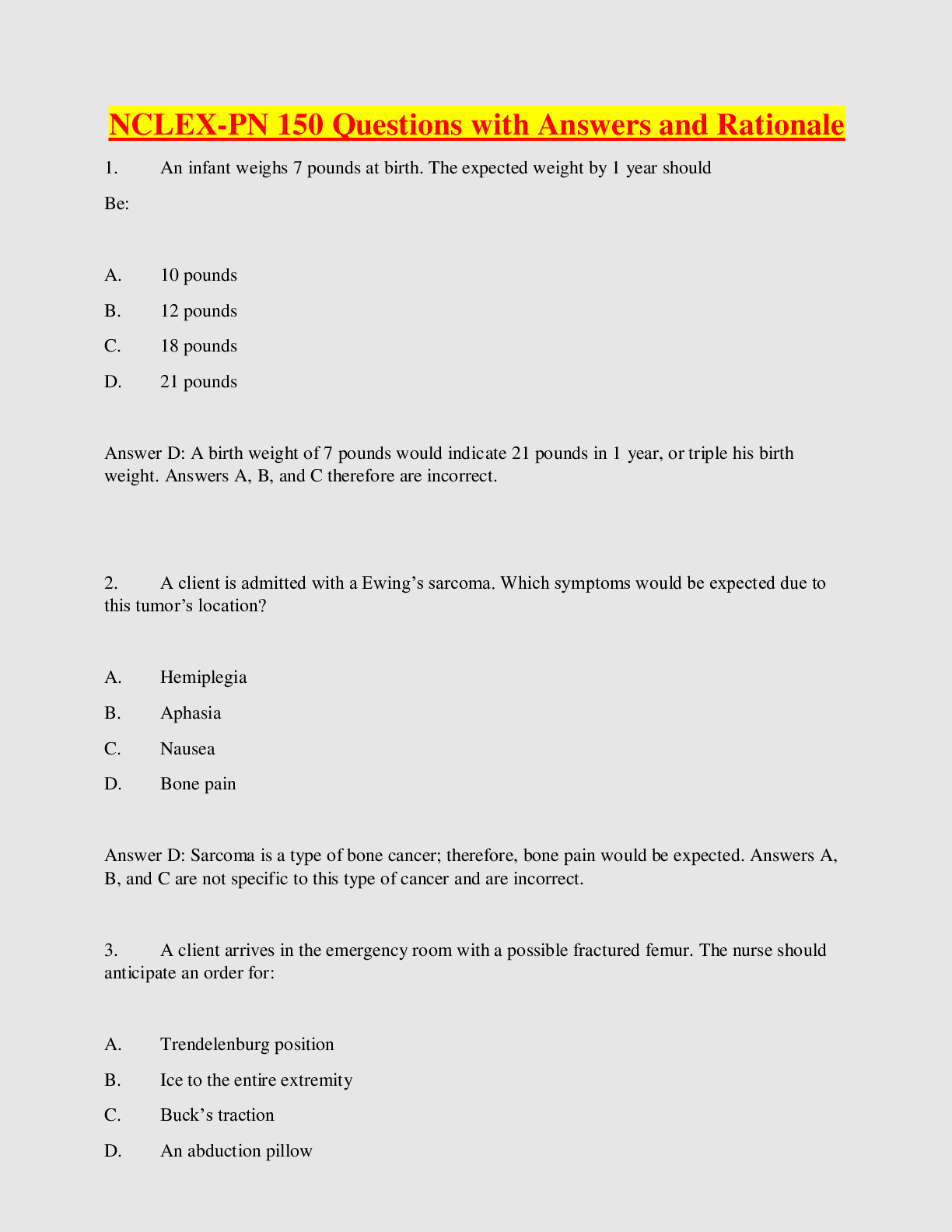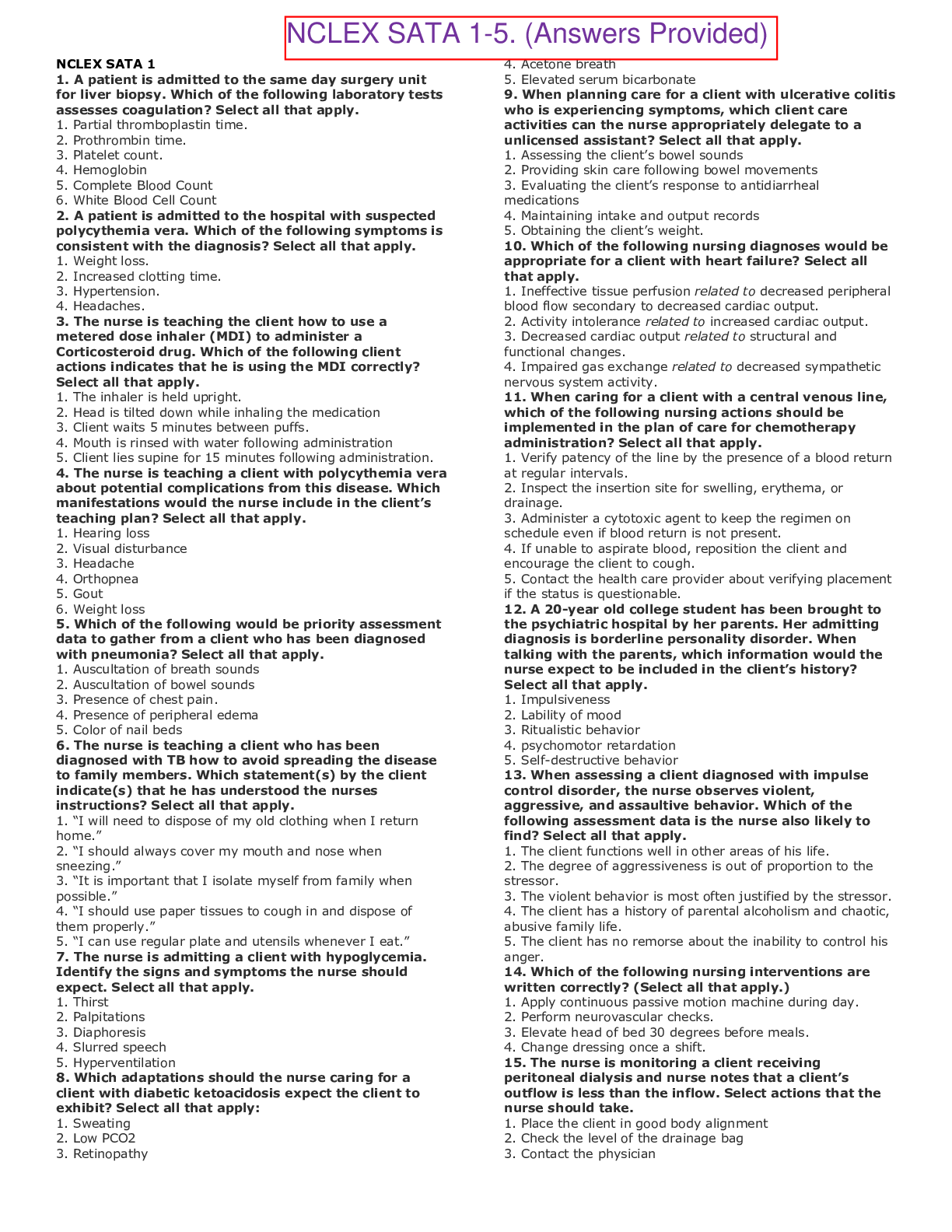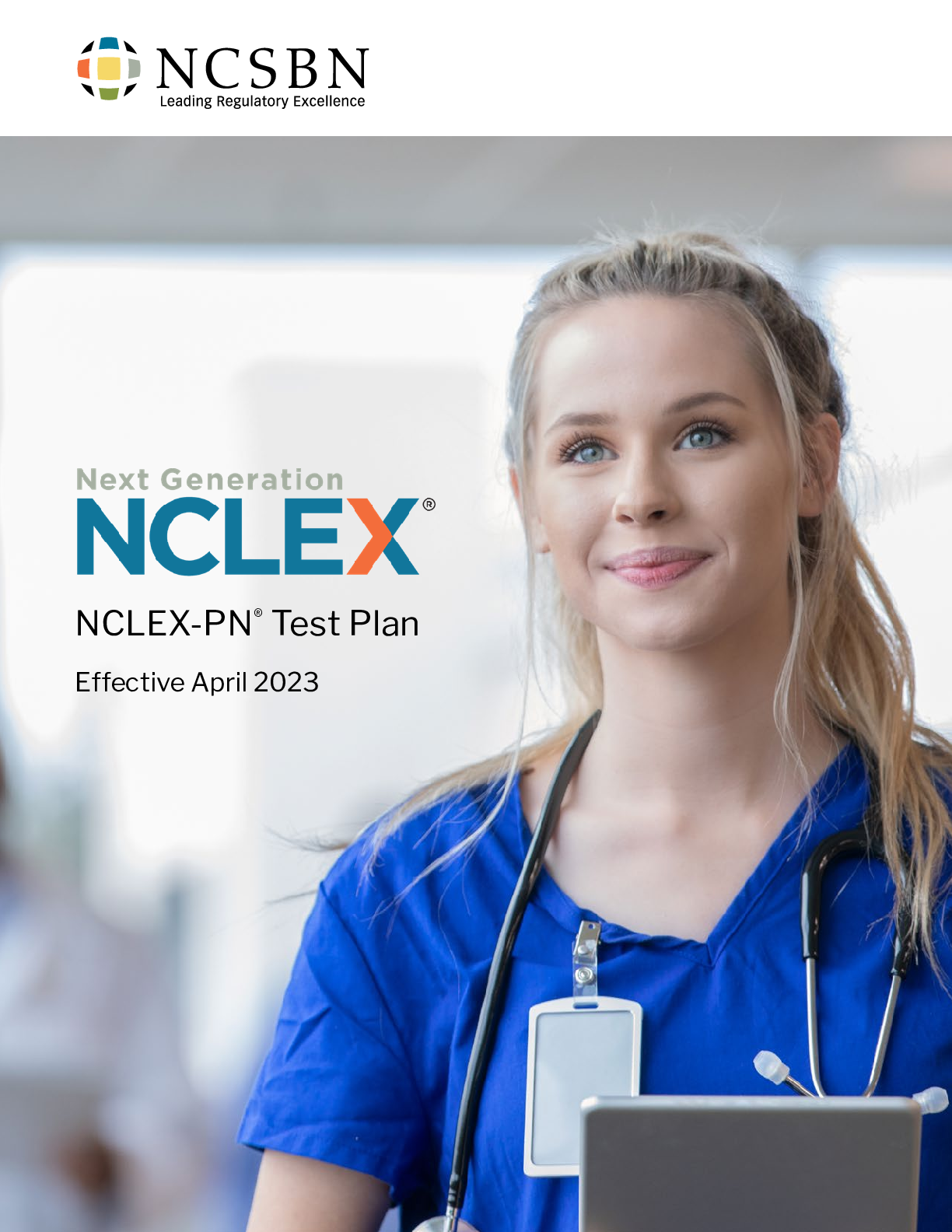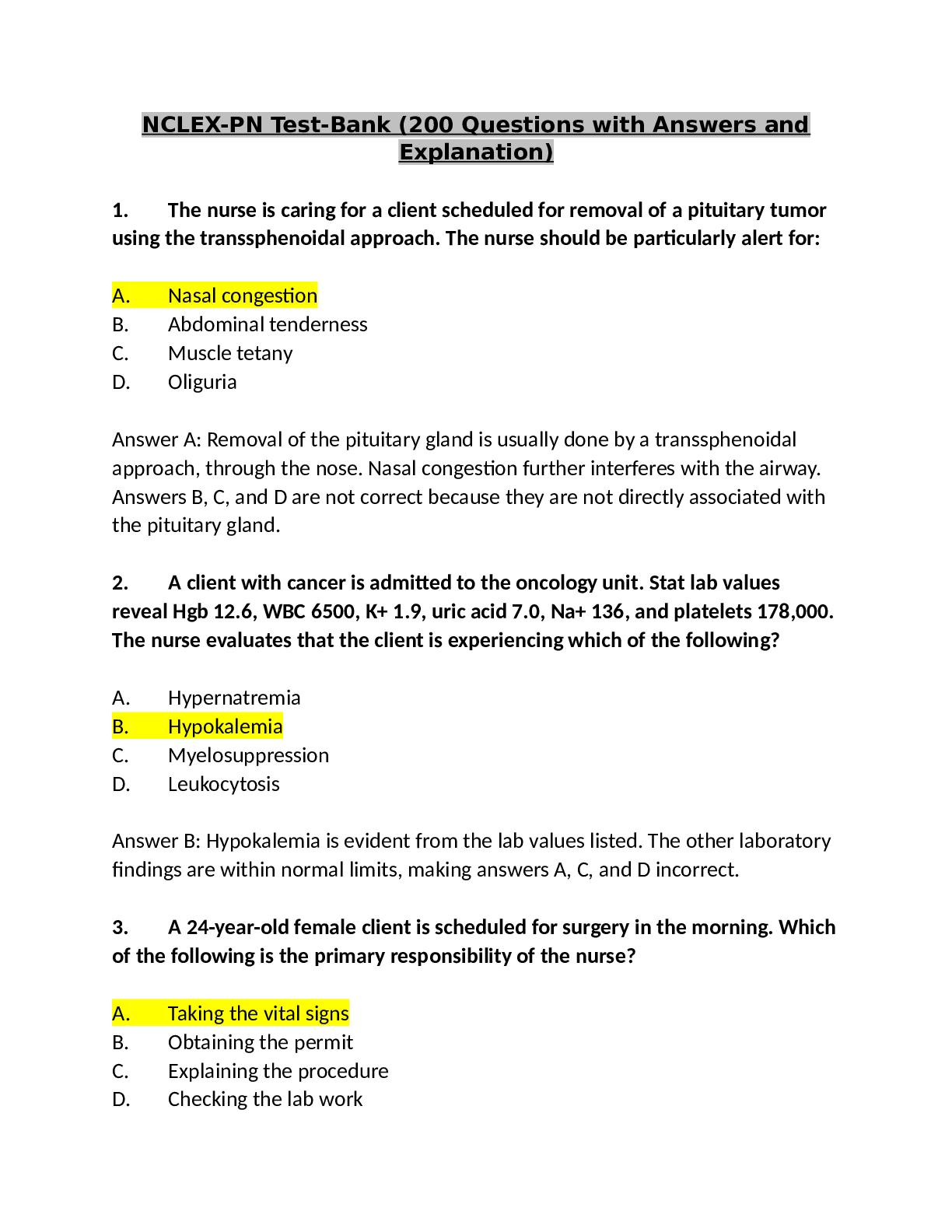Medical Studies > NCLEX-PN > NCLEX QUESTION TRAINER EXPLANATIONS TEST 2 | Med Surg 2210 NCLEX TEST 2 WITH EXPLANATIONS (All)
NCLEX QUESTION TRAINER EXPLANATIONS TEST 2 | Med Surg 2210 NCLEX TEST 2 WITH EXPLANATIONS
Document Content and Description Below
NCLEX QUESTION TRAINER EXPLANATIONS TEST 2 1. The nurse is supervising care given to a group of patients on the unit. The nurse observes a staff member entering a patient’s room wearing gown and ... gloves. The nurse knows that the staff member is caring for which of the following patients? 1. An 18-month-old with respiratory syncytial virus. 2. A 4-year-old with Kawasaki disease. 3. A 10-year-old with Lyme’s disease. 4. A 16-year-old with infectious mononucleosis. Strategy: Think about each answer. (1) correct–acute viral infection; requires contact precautions; assign to private room or with other RSV-infected children (2) acute systemic vasculitis in children under 5; standard precautions (3) connective tissue disease; standard precautions (4) standard precautions 2. The nurse is assessing a client who has had a spinal cord injury. Which of the following assessment findings would suggest the complication of autonomic dysreflexia? 1. Urinary bladder spasm pain. 2. Severe pounding headache. 3. Tachycardia. 4. Severe hypotension. Strategy: Think about each answer. (1) may be the cause of autonomic dysreflexia due to overfilling of the bladder, but pain is not perceived (2) correct–severe headache results from rapid onset of hypertension (3) pulse will slow (4) BP will increaseP R E P A R A T I O N F O R T H E N U R S I N G L I C E N S U R E E X A M I N A T I O N ................................................ 16 ............................................................................................................................................................................................................................................................................ Nursing 3. A 14-year-old client is scheduled for a below-knee (BK) amputation following a motorcycle accident. The nurse knows preoperative teaching for this client should include 1. explaining that the client will be walking with a prosthesis soon after surgery. 2. encouraging the client to share his feelings and fears about the surgery. 3. taking the informed consent form to the client and asking him to sign it. 4. evaluating how the client plans to maintain his schoolwork during hospitalization. Strategy: Remember therapeutic communication. (1) fails to recognize his immediate concerns (2) correct–discussing his feelings and fears is important in dealing with his anxiety due to a change in body image and functioning (3) client is underage; parents will need to sign the permit (4) is more appropriate for the postoperative period of time than for the preoperative period 4. A 21-year-old woman at 16-weeks gestation undergoes an amniocentesis. The client asks the nurse what the physician will learn from this procedure. The nurse’s response should be based on an understanding that which of the following conditions can be detected by this test? 1. Tetralogy of Fallot. 2. Talipes equinovarus. 3. Hemolytic disease of the newborn. 4. Cleft lip and palate. Strategy: Think about each answer. (1) cardiac abnormality detected at birth; pulmonary stenosis, ventricular septal defect, overriding aorta, hypertrophy of right ventricle (2) congenital deformity detected at birth; foot twisted out of normal position, clubfoot (3) correct–maternal antibodies destroy fetal RBCs; bilirubin secreted because of hemolysis (4) congenital deformity detected at birth, midline fissure or opening into lip or palate 5. The nurse evaluates the nutritional intake of a 16-year-old girl at a camp for adolescents. The girl eats all of the food provided to her at the camp cafeteria. Each of the day’s three meals contains foods from all areas of the food pyramid, and each meal averages about 900 calories and 3 mg of iron. The girl has been menstruating monthly for about two years. Which of the following descriptions, if made by the nurse, BEST describes the girl’s intake if her weight is appropriate for her height? 1. Her diet is low in calories and high in iron. 2. Her diet is low in calories and low in iron. 3. Her diet is high in calories and low in iron. 4. Her diet is high in calories and high in iron. Strategy: Think about each answer. (1) only 1,200-1,500 kcal/day required, and 15 mg/day of iron (2) only 1,200-1,500 kcal/day required (3) correct–900 x 3 = 2,700 calories/day and women need 1,200-1,500 kcal/day (men need 1,500- 1,800 kcal/day); 3 mg x 3 = 9 mg/day of iron and women need 15 mg/day of iron (men need 10 mg/day); with pregnancy 30 mg/day required (4) 5 mg/day of iron required............................................................................................................................ N C L E X Q U E S T I O N T R A I N E R Nursing ........................................................................................................................................................................................................................................................................... 17 6. A client has returned from surgery with a fine, reddened rash noted around the area where Betadine prep had been applied prior to surgery. Nursing documentation in the chart should include 1. the time and circumstances under which the rash was noted. 2. the explanation given to the client and family of the reason for the rash. 3. notation on an allergy list and notification of the doctor. 4. the need for application of corticosteroid cream to decrease inflammation. Strategy: Answers are implementation. Determine the outcome of each answer. Is it desired? (1) would be noted, but is not as high a priority (2) inappropriate (3) correct–suspected reaction to drugs should be reported to the doctor and noted on list of possible allergies (4) inappropriate 7. A client who is receiving a blood transfusion experiences a hemolytic reaction. The nurse would anticipate which of the following assessment findings? 1. Hypotension, backache, low back pain, fever. 2. Wet breath sounds, severe shortness of breath. 3. Chills and fever occurring about an hour after the infusion started. 4. Urticaria, itching, respiratory distress. Strategy: Think about each answer. (1) correct–signs and symptoms of a hemolytic reaction include chills, headache, backache, dyspnea, cyanosis, chest pains, tachycardia, and hypotension (2) describes symptoms of circulatory overload (3) describes a febrile or pyrogenic reaction (4) describes an allergic reaction 8. The nurse is developing a comprehensive care plan for a young woman with an eating disorder. The nurse refers this client to assertiveness skills classes. The nurse knows that this is an appropriate intervention because this client may have problems with 1. aggressive behaviors and angry feelings. 2. self-identity and self-esteem. 3. focusing on reality. 4. family boundary intrusions. Strategy: Think about each answer. (1) these clients do have problems with feelings of anger; family therapy sessions can be helpful in identifying some of these feelings and difficulties with family boundaries (2) correct–clients with eating disorders experience difficulty with self-identity and self-esteem, which inhibits their abilities to act assertively; some assertiveness techniques that are taught include giving and receiving criticism, giving and accepting compliments, accepting apologies, being able to say no, and setting limits on what they can realistically do rather than just doing what others want them to do (3) do not have problems with reality (4) these clients do have problems with family boundary intrusion; family therapy sessions can be helpful in identifying some of these feelings and difficulties with family boundaries - - - - - - - - - - - - - - - - - - - - - - - - - - - - - - - - - - - - - - 65. During the development of a nursing care plan, the nurse should consider which of the following clients for the use of a restraint? 1. An infant with septicemia. 2. A child with a tonsillectomy. 3. An infant with cleft lip repair. 4. A child with meningitis. Strategy: Think about each answer. (1) not in need of restraints (2) not in need of restraints (3) correct–arm restraints are necessary to prevent infant from rubbing or otherwise disturbing suture line (4) not in need of restraints............................................................................................................................ N C L E X Q U E S T I O N T R A I N E R Nursing ........................................................................................................................................................................................................................................................................... 37 66. A client has developed a low intestinal obstruction. The nurse would anticipate which of the following findings? 1. Nausea, vomiting, abdominal distention. 2. Explosive, irritating diarrhea. 3. Abdominal tenderness with rectal bleeding. 4. Midepigastric discomfort, tarry stool. Strategy: Determine how each answer relates to an intestinal obstruction. (1) correct–there is distention above the level of obstruction and initially hyperactive bowel sounds; would be no stool, as motility distal to (below) the obstruction would cease (2) would be no diarrhea (3) would be no rectal bleeding, abdomen would be distended (4) would be no GI bleeding 67. A 42-year-old man with metastatic lung cancer is admitted to the hospital. His orders include: do not resuscitate (DNR) and morphine 2 mg/h by continuous IV infusion. When the nurse assesses him, his BP is 86/50, respirations are 8, and he is nonresponsive. Naloxone hydrochloride (Narcan), 0.4 mg IV, is ordered STAT. In planning care for this man, it is IMPORTANT for the nurse to know that 1. the BP and respirations will need to increase before a second dose of Narcan can be given. 2. Narcan should not be given to the man because of his DNR status. 3. a dose of Narcan may need to be repeated in 2–3 minutes. 4. Narcan is effective in treating respiratory changes caused by opiates, barbiturates, and sedatives. Strategy: Think about each answer. (1) will not change without Narcan, respirations increase within 2 min (2) DNR indicates no resuscitation should be done if heart stops; does not preclude administration of drugs to correct iatrogenic problems (3) correct–half-life of Narcan is short; may go back into respiratory depression; may need to be repeated (4) used for respiratory depression of opiates, not used with barbiturates or sedatives 68. In planning discharge teaching for a client after a lumbar laminectomy, the nurse would instruct the client to exercise regularly to strengthen which muscles? 1. Anal sphincter. 2. Abdominal. 3. Trapezius. 4. Rectus femoris. Strategy: Think about each answer. (1) does not contribute to support of the lumbar spine (2) correct–strengthening the abdominal muscles adds support for the muscles supporting the lumbar spine (3) does not contribute to support of the lumbar spine (4) does not contribute to support of the lumbar spineP R E P A R A T I O N F O R T H E N U R S I N G L I C E N S U R E E X A M I N A T I O N ................................................ 38 ............................................................................................................................................................................................................................................................................ Nursing 69. The nurse is planning care for a client with a diagnosis of paranoid schizophrenia. The nurse knows that questioning the client about his false ideas will 1. cause him to defend the idea. 2. help him clarify his thoughts. 3. facilitate better communication. 4. lead to a breakdown of the defense. Strategy: Think about each answer. (1) correct–contraindicated; encourages patient to engage in further distortion of reality (2) needs reality testing from nurse, not questioning (3) questioning is nontherapeutic; may cause patient to avoid nurse physically (4) needs defense; questioning will further distort reality or elaborate on delusion 70. When assessing orientation to person, place, and time for an elderly hospitalized client, which of the following principles should be understood by the nurse? 1. Short-term memory is more efficient than long-term memory. 2. The stress of an unfamiliar environment may cause confusion. 3. A decline in mental status is a normal part of aging. 4. Learning ability is reduced during hospitalization of the elderly client. Strategy: Think about each answer. (1) just the opposite is true; long-term memory is more efficient than short-term memory (2) correct–stress of an unfamiliar situation or environment may lead to confusion in elderly clients (3) mental status and learning ability are not affected by aging, although elderly client may be slower at doing things (4) mental status and learning ability are not affected by aging, although elderly client may be slower at doing things 71. Which of the following assessment findings should the nurse recognize as pertinent to a diagnosis of Cushing’s syndrome? 1. Low blood pressure and weight loss. 2. Thin extremities with easy bruising. 3. Decreased urinary output and decreased serum potassium. 4. Tachycardia with complaints of night sweats. Strategy: Think about each answer. (1) BP increases and client gains weight (2) correct–clients with Cushing's syndrome tend to lose weight in their legs and have petechiae and bruising (3) no correlation with urinary output; potassium increases (4) no correlation with Cushing's syndrome............................................................................................................................ N C L E X Q U E S T I O N T R A I N E R Nursing ........................................................................................................................................................................................................................................................................... 39 72. A patient with type I diabetes mellitus (IDDM) asks the nurse why the doctor ordered human insulin instead of beef or pork insulin. Which of the following responses by the nurse is BEST? 1. “Human insulin is less likely to cause you to have a localized allergic reaction to the injection.” 2. “Human insulin will cause you to experience fewer problems with hypoglycemia or hyperglycemia.” 3. “Human insulin prevents the development of long-term damage to the eyes and kidneys.” 4. “Human insulin does not cause the formation of antibodies because the protein structure is identical to your own.” Strategy: Think about each answer. (1) reactions caused by preservatives in insulin, which is same for all types of insulin (2) no change in incidence of hypoglycemia or hyperglycemia (3) complications are caused by blood vessel damage from sugar and fat deposits, not type of insulin used (4) correct–protein molecules are identical with human insulin 73. A client with acquired immunodeficiency syndrome (AIDS) is admitted with a tentative diagnosis of late AIDS dementia complex. The nursing assessment is most likely to reveal which of the following? 1. Hyperactive deep tendon reflexes. 2. Peripheral neuropathy affecting the hands. 3. Disorientation to person, place, and time. 4. Impaired concentration and memory loss. Strategy: Think about each answer and how it relates to AIDS-related dementia. (1) not relevant to this condition (2) not relevant to this condition (3) correct–approximately 65% of AIDS clients demonstrate a progressive dementia staged according to severity of debilitation; late stage is typified by cognitive confusion and disorientation (4) is a sign of early onset dementia 74. What are two major side effects of haloperidol (Haldol) the nurse should anticipate? 1. Blood dyscrasia and extrapyramidal symptoms. 2. Hearing loss and unsteady gait. 3. Nystagmus and vertical gaze palsy. 4. Alteration in level of consciousness and increased confusion. Strategy: Think about each answer. (1) correct–major side effects of haloperidol (Haldol) include hematologic problems, primarily blood dyscrasia and extrapyramidal symptoms (EPS) (2) not seen with haloperidol (3) not seen with haloperidol (4) not seen with haloperidolP R E P A R A T I O N F O R T H E N U R S I N G L I C E N S U R E E X A M I N A T I O N ................................................ 40 ............................................................................................................................................................................................................................................................................ Nursing 75. A home care nurse is planning activities for the day. Which of the following clients should the nurse see FIRST? 1. A new mother is breastfeeding her two-day-old infant who was born five days early. 2. A man discharged yesterday following treatment with IV heparin for a deep vein thrombosis. 3. An elderly woman discharged from the hospital three days ago with pneumonia. 4. An elderly man who used all his diuretic medication and is expectorating pink-tinged mucus. Strategy: Determine the least stable client. Think ABCs. (1) stable situation, not a priority (2) assess for bleeding gums, hematuria, not the priority (3) assess breath sounds, encourage fluids, cough and deep breathe (4) correct–symptoms of pulmonary edema; requires immediate attention [Show More]
Last updated: 1 year ago
Preview 1 out of 26 pages
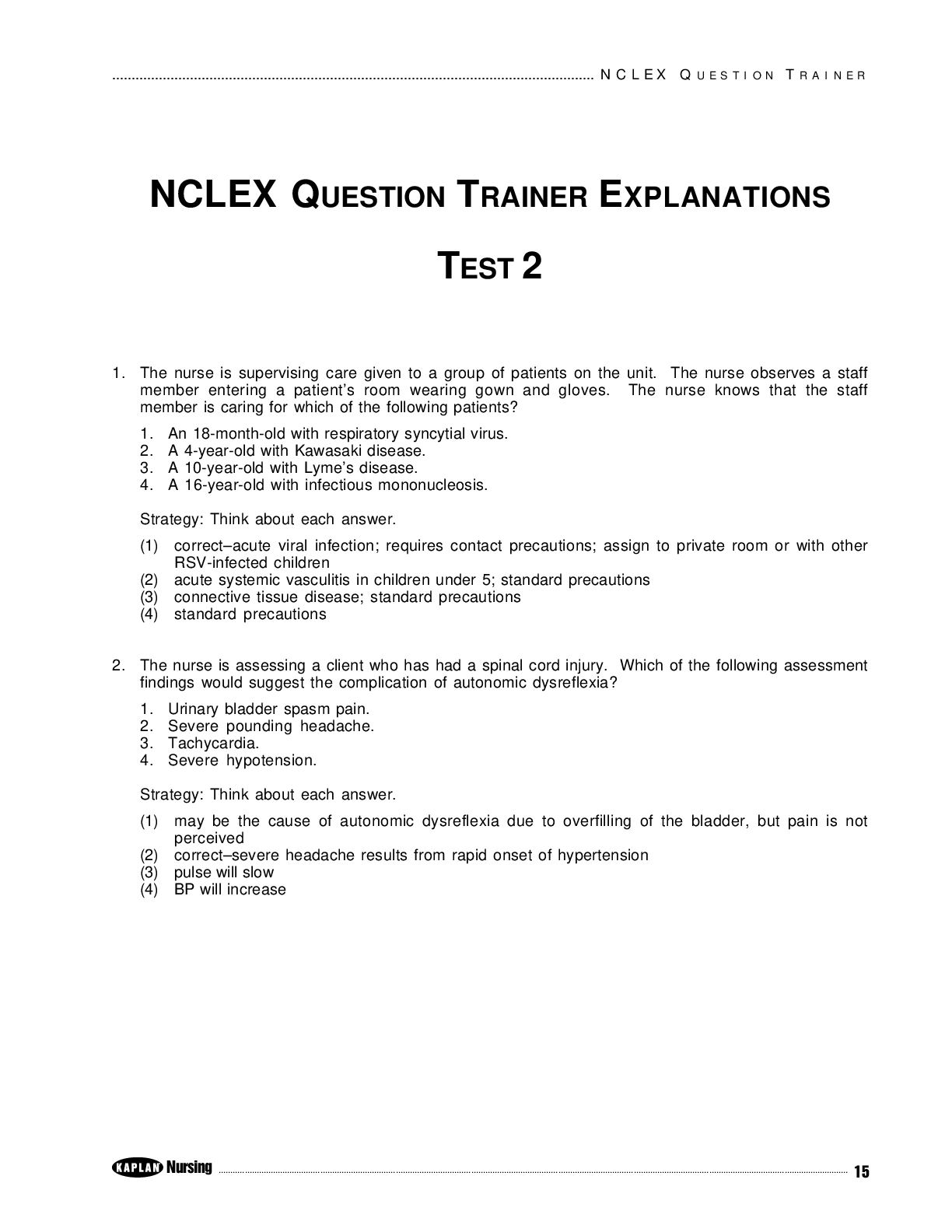
Reviews( 0 )
Document information
Connected school, study & course
About the document
Uploaded On
Aug 04, 2020
Number of pages
26
Written in
Additional information
This document has been written for:
Uploaded
Aug 04, 2020
Downloads
0
Views
94

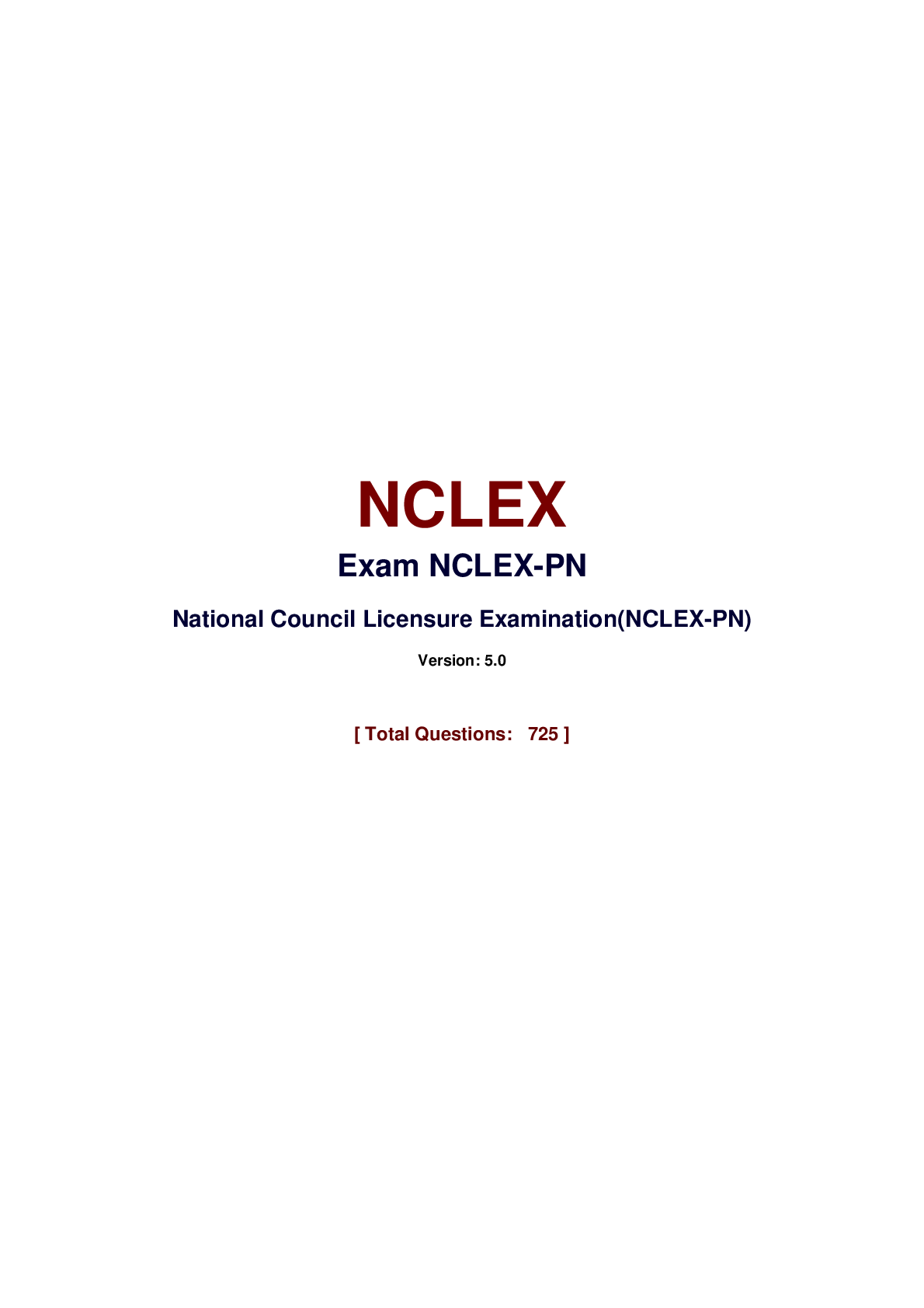

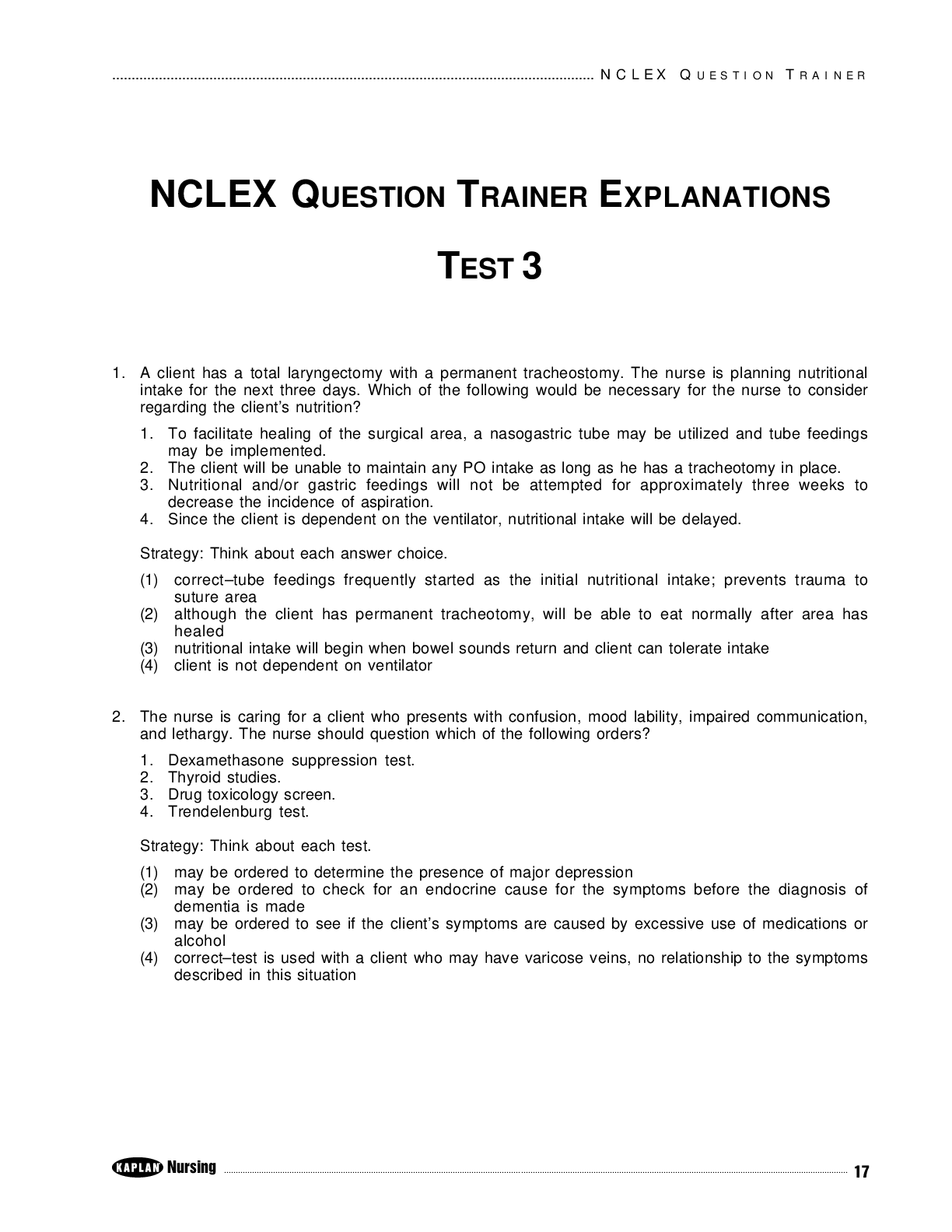
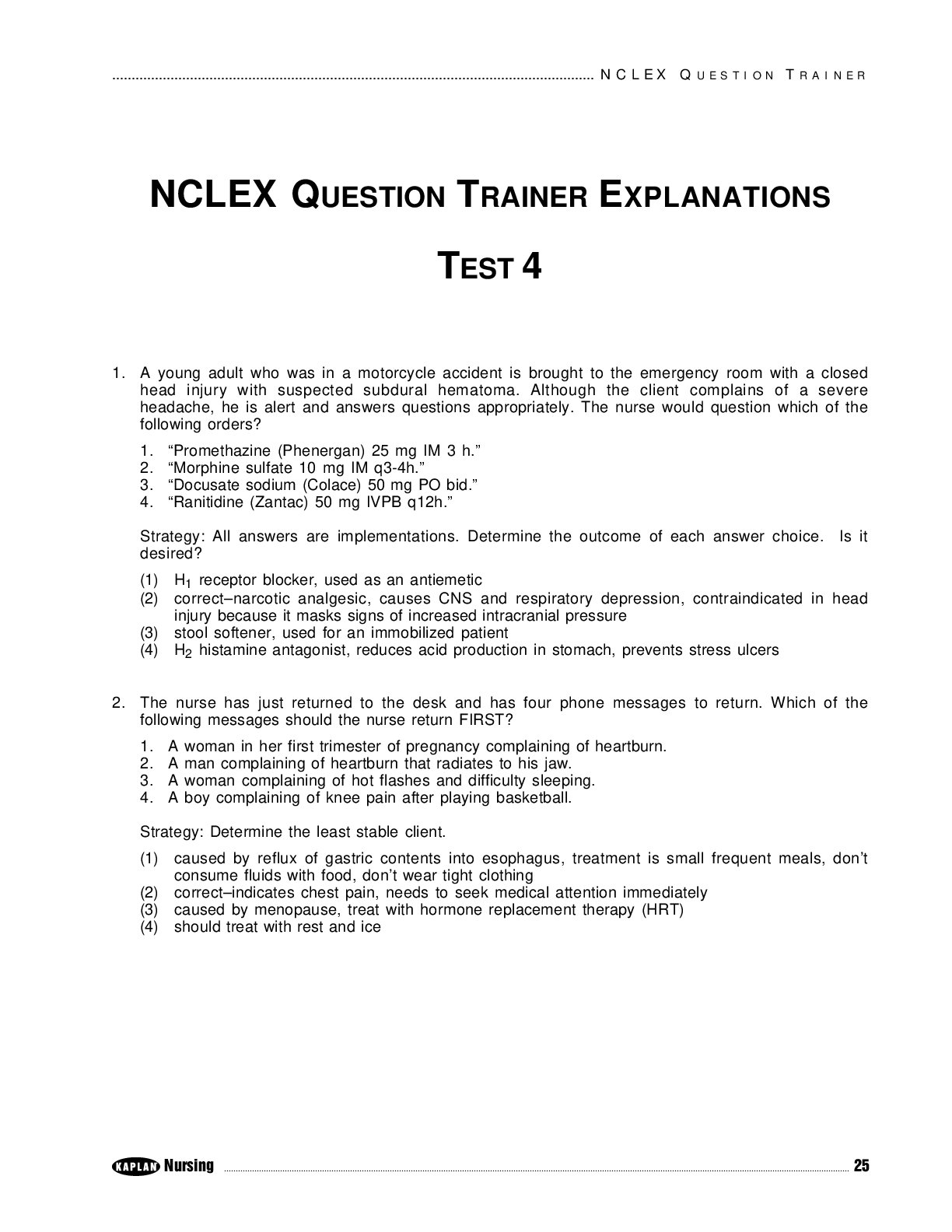
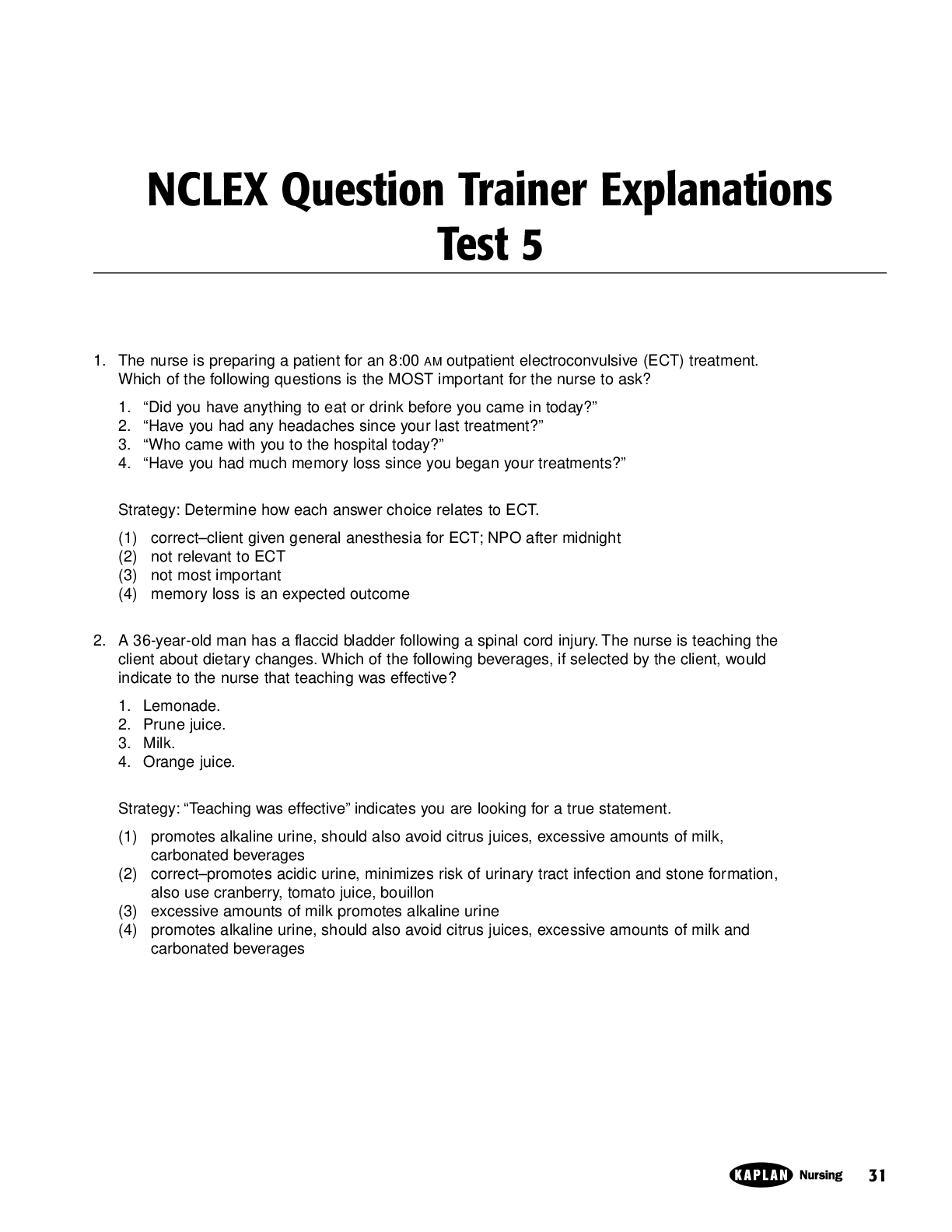
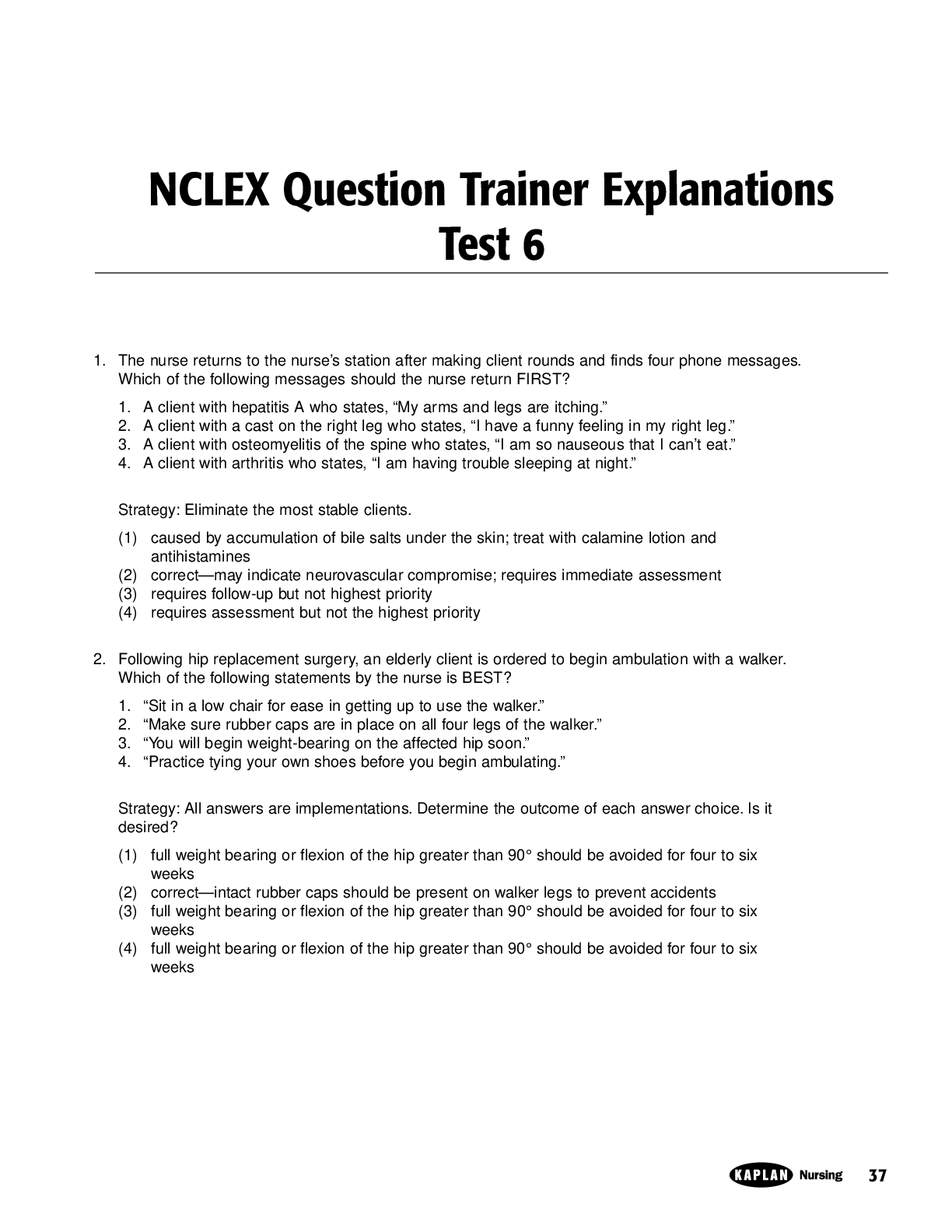
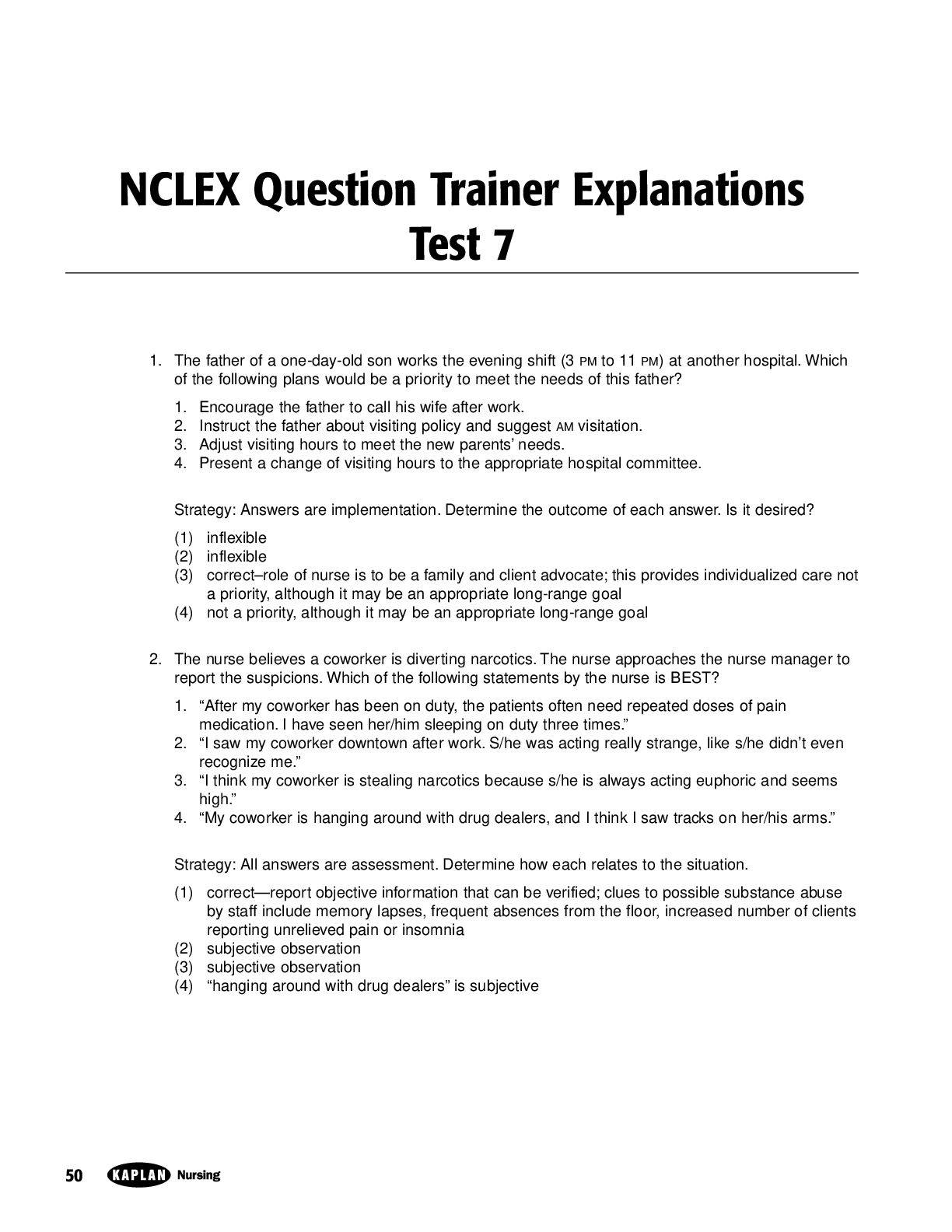
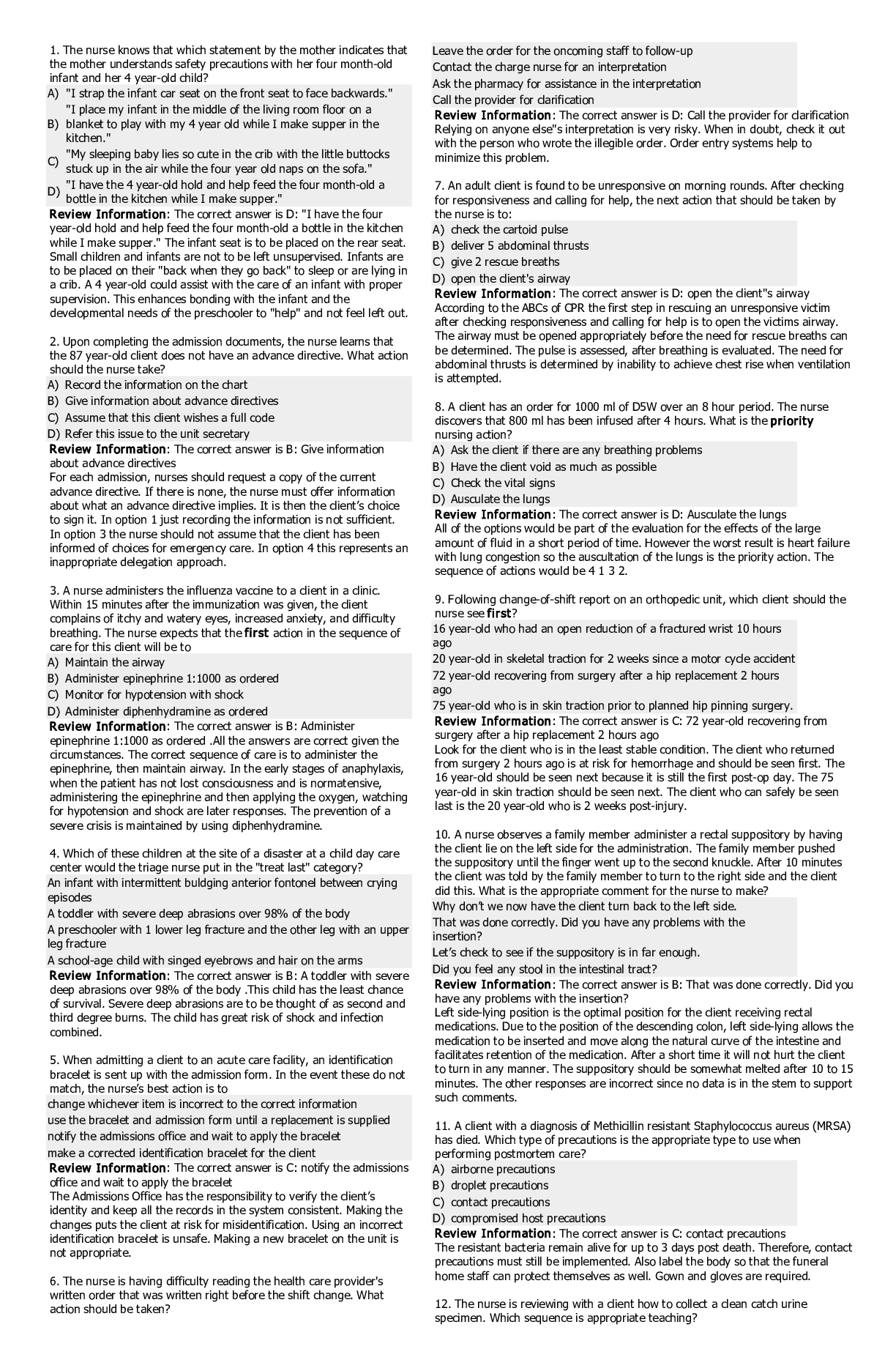
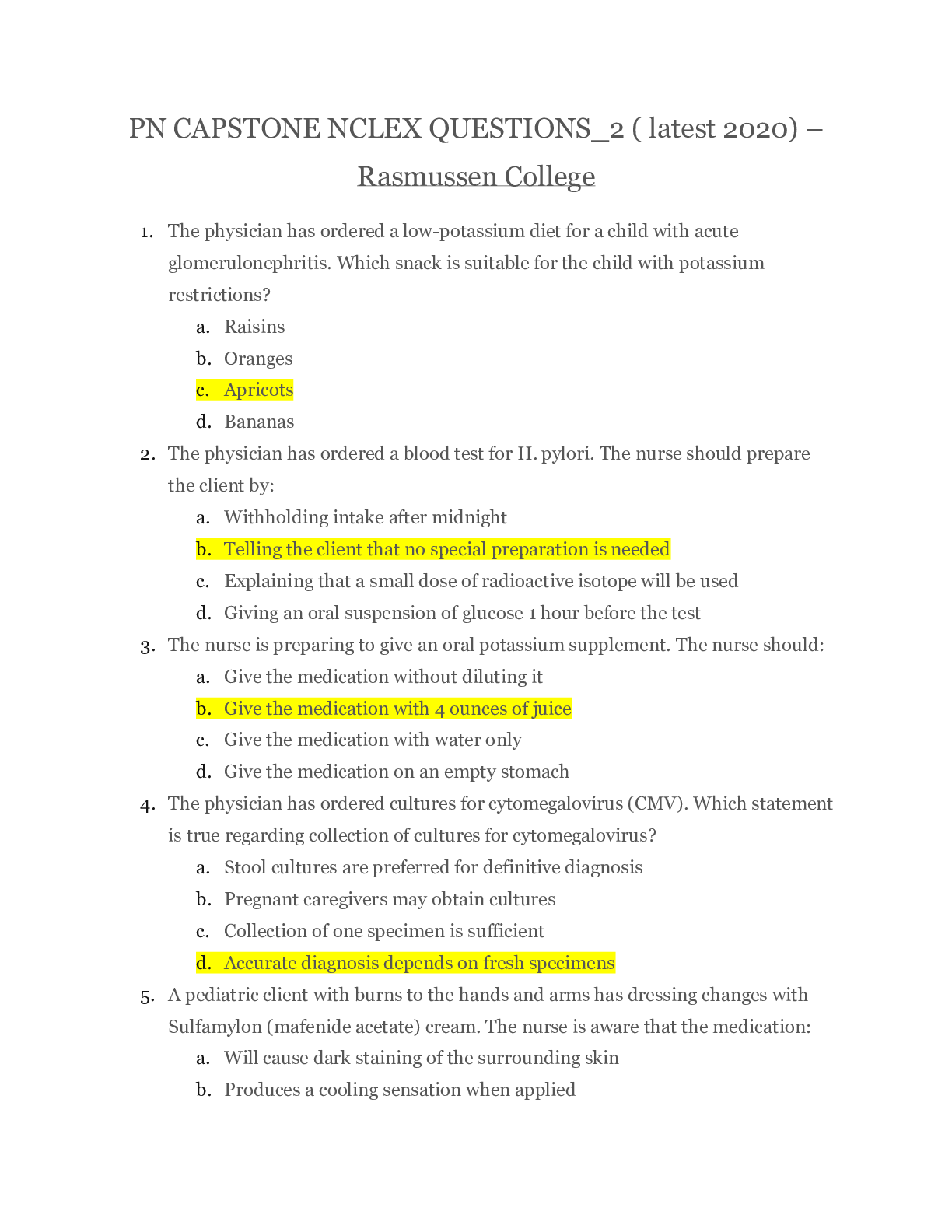

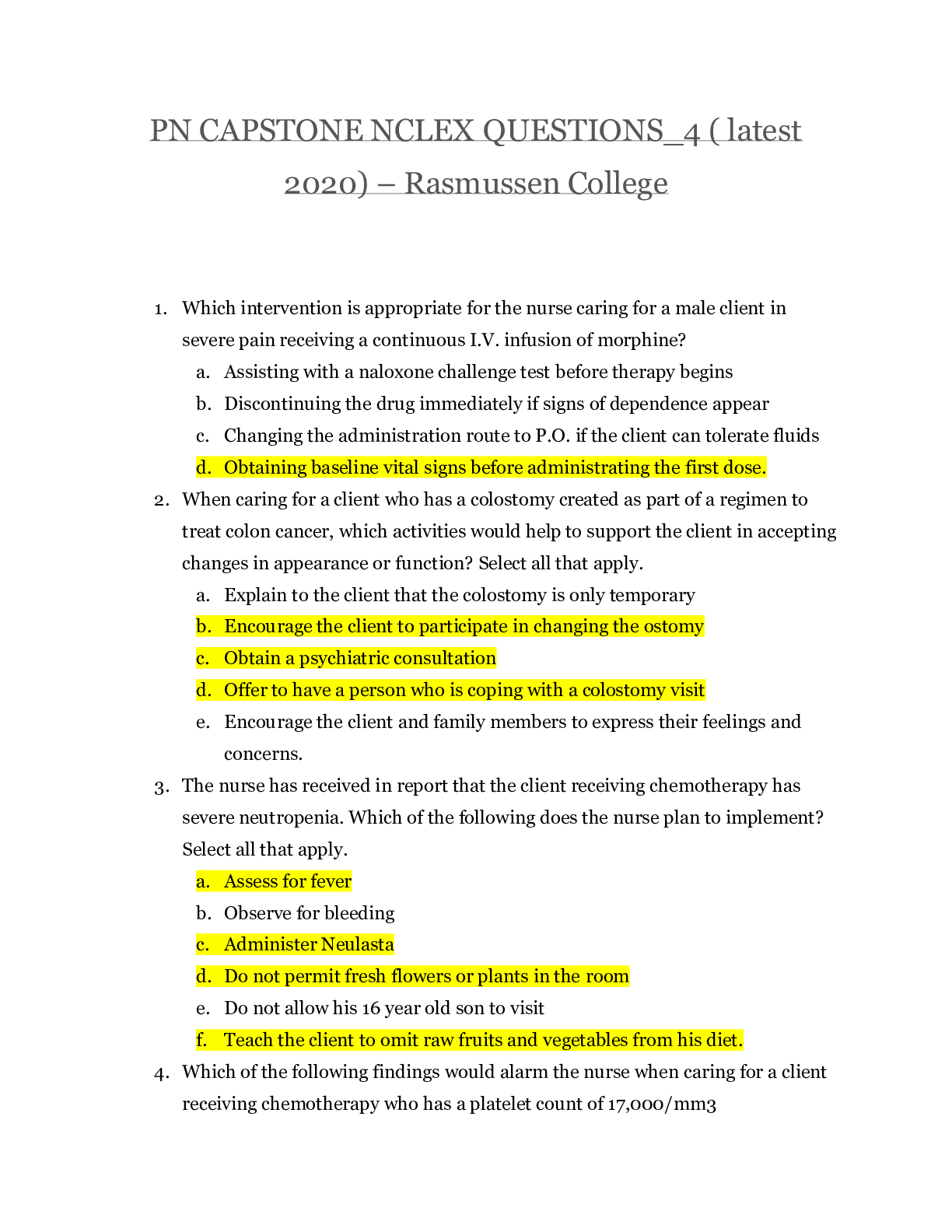


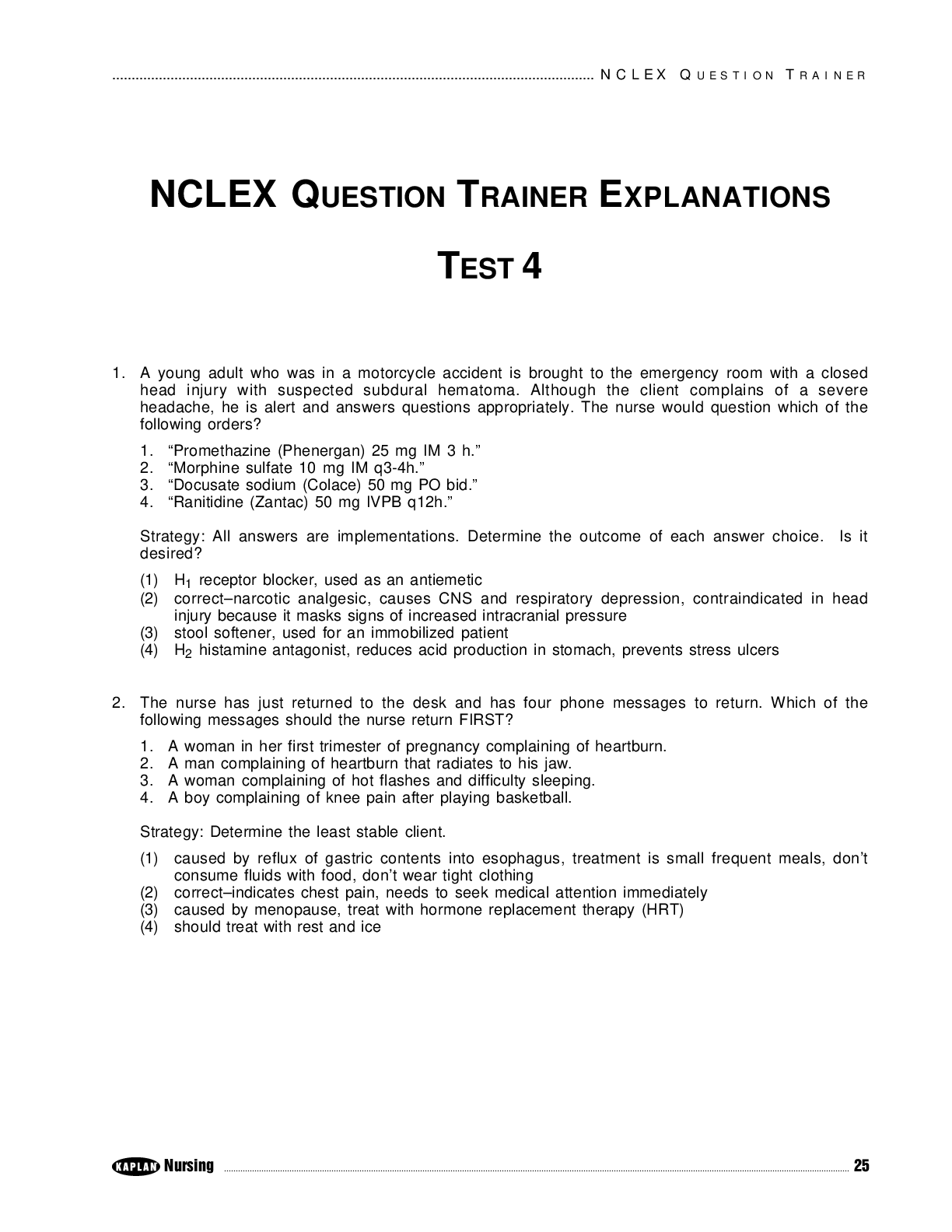
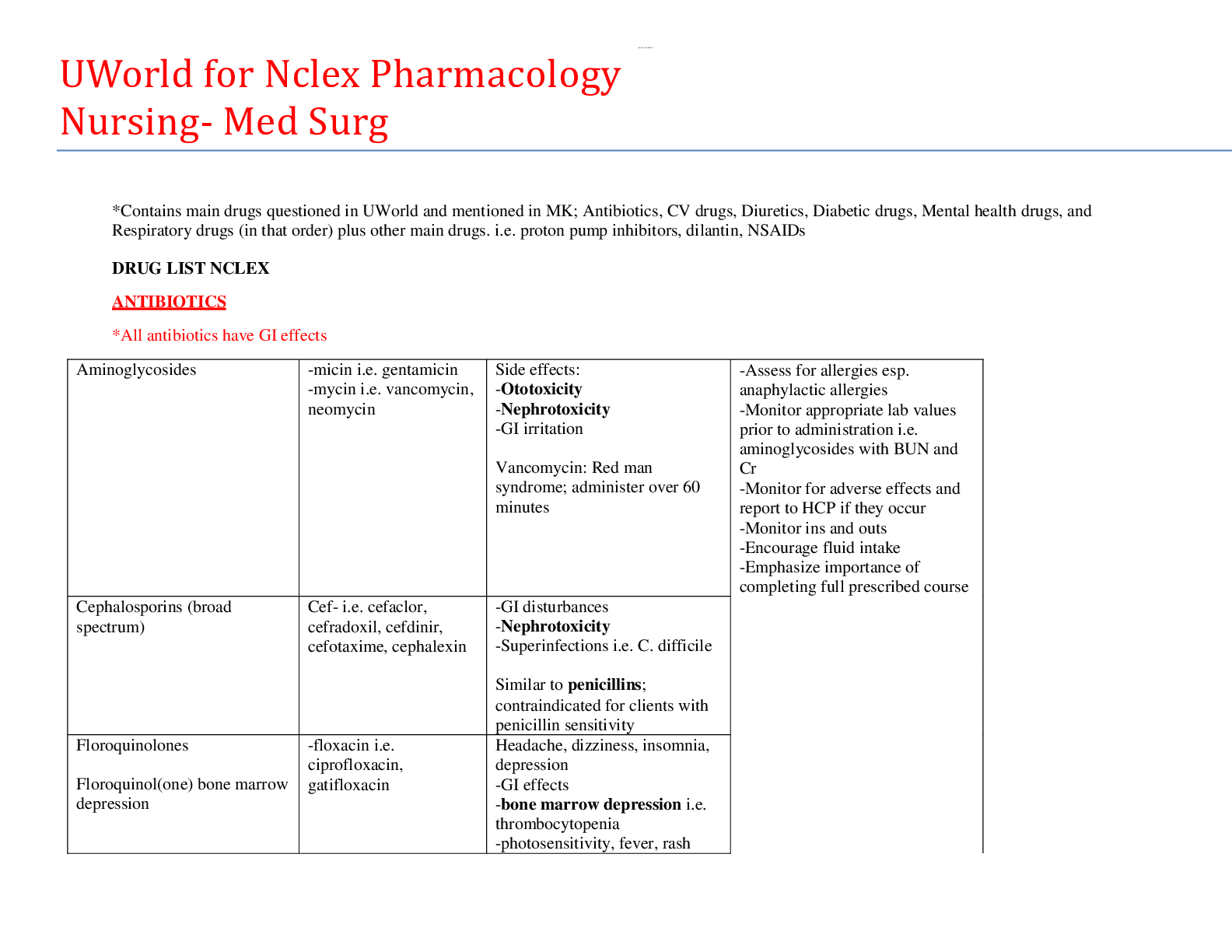

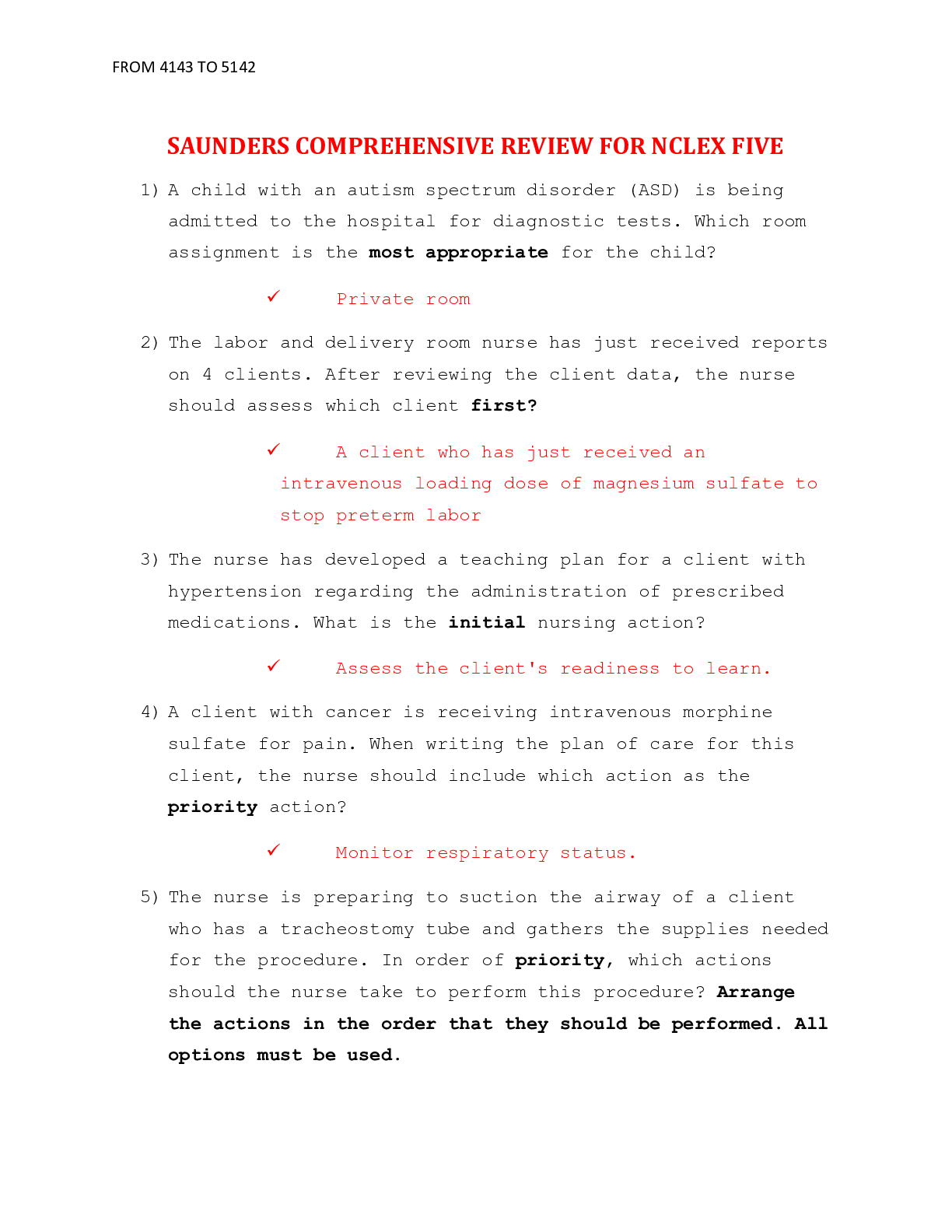
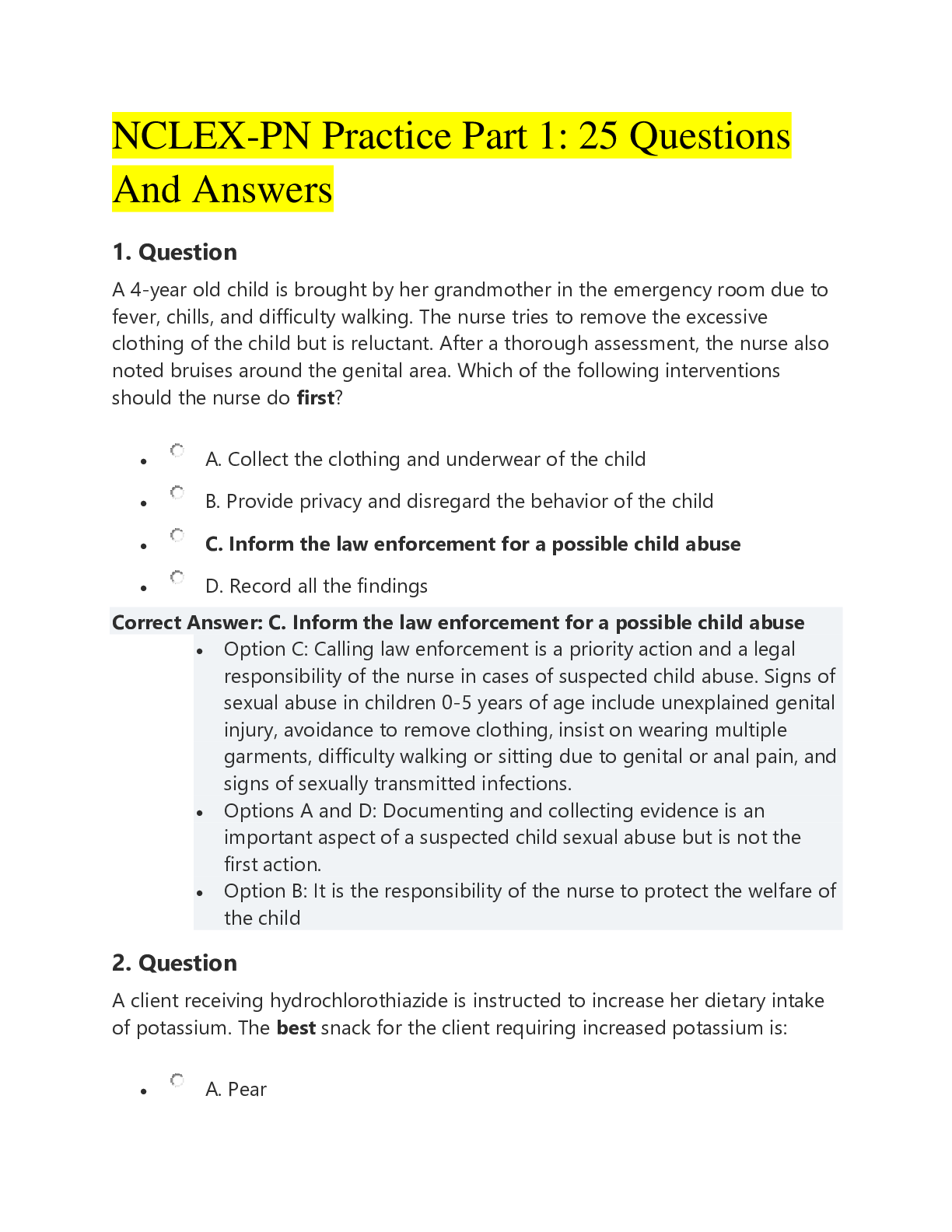
.png)
